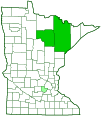western Jacob’s ladder
(Polemonium occidentale ssp. lacustre)
Conservation • Wetland • Description • Habitat • Ecology • Use • Distribution • Taxonomy
Description |
||
Western Jacob’s ladder is an erect, perennial, up to 40″ tall forb that rises on a single stem from the upturned end of a short, slender, unbranched, horizontal, underground stem (rhizome). The leaves are alternate. Lower leaves are pinnately divided into up to 27 narrow leaflets. The leaflets are lance-shaped, ⅜″ to 1½″ long, and stalkless or almost stalkless. The margins are untoothed. The leaves get smaller and less divided as they ascend the stem. The leaf subtending the flowering stalk has 9 to 13 leaflets. The inflorescence is a crowded, elongated, somewhat cylinder-shaped or egg-shaped, branched array (panicle) of several small clusters of flowers. The flowers are bell-shaped and ⅜″ to ⅝″ long and wide. They are on 3 ⁄16″ to ¼″ long stalks, the stalks at least as long as the sepals. There are 5 sepals, 5 petals, 5 stamens, and 1 style. The sepals are green and form a bell-shaped structure (calyx) that is longer than the stalk of the flower. The petals are mostly blue but white at the base. They are joined at the base into a corolla tube then separated at the tip into 5 broadly triangular, widely spreading lobes that are longer than the tube. The stamens are as long as, or a little shorter than, the corolla. The anthers are white. The style is conspicuously longer than the stamens. The fruit is a egg-shaped to round, 3-chambered, to ⅛″ long capsule with 1 to 10 seeds per chamber. |
||
Height |
||
Up to 40″ tall |
||
Flower Color |
||
Blue |
||
Similar Species |
||
Charity (Polemonium caeruleum) is a garden plant that sometimes escapes cultivation. The leaf subtending the flowering stalk has only 3 to 7 leaflets. The corolla is purple to flesh-pink, not blue. The capsule is larger, ¼″ to 5 ⁄16″ long. |
||
Habitat |
||
Wet. Openings in conifer swamps with a blanket of sphagnum and other mosses and dominated by northern white cedar and sometimes tamarack and/or black spruce. Full or partial sun. |
||
Ecology |
||
Flowering |
||
Late June to July |
||
Pests and Diseases |
||
|
||
Use |
||
|
||
Distribution |
||||
|
Sources 2, 3, 4, 5, 6, 24, 28, 29, 30. There are only six known populations of this plant, two in Wisconsin and four in Minnesota. All of the Minnesota sightings were in conifer swamps that been selectively logged. Three of the Minnesota populations are within 50 miles of each other in St. Louis County. One of those was found in 1944 but has never been found again. The fourth is in a conifer swamp in southeastern Itasca county. The sighting in Carver County (light green on the map) is at the Minnesota Landscape Arboretum. Arboretum plantings are not “outside of cultivation.” |
|||
| 7/5/2023 | ||||
Nativity |
||||
Native |
||||
Occurrence |
||||
Rare |
||||
Taxonomy |
|||
| Kingdom | Plantae (Plants) | ||
| Subkingdom | Pteridobiotina | ||
| Phylum | Tracheophyta (Vascular Plants) | ||
| Class | Magnoliopsida (Dicots) | ||
Order |
Ericales (heathers, balsams, primroses, and allies) | ||
Family |
Polemoniaceae (phlox) | ||
| Subfamily | Polemonioideae | ||
Genus |
Polemonium (Jacob’s ladders) | ||
| Species | Polemonium occidentale (western Jacob’s ladder) | ||
Subordinate Taxa |
|||
Synonyms |
|||
Polemonium lacustre Polemonium occidentale var. lacustre |
|||
Common Names |
|||
western Jacob’s ladder western Jacob’s-ladder western polemonium |
|||
Glossary
Corolla
A collective name for all of the petals of a flower.
Panicle
A pyramidal inflorescence with a main stem and branches. Flowers on the lower, longer branches mature earlier than those on the shorter, upper ones.
Pinnate
On a compound leaf, having the leaflets arranged on opposite sides of a common stalk. On a bryophyte, having branches evenly arranged on opposite sides of a stem.
Rhizome
A horizontal, usually underground stem. It serves as a reproductive structure, producing roots below and shoots above at the nodes.
Sepal
An outer floral leaf, usually green but sometimes colored, at the base of a flower.
Visitor Photos |
|||||
Share your photo of this plant. |
|||||
| This button not working for you? Simply email us at info@MinnesotaSeasons.com. Attach one or more photos and, if you like, a caption. |
|||||
Katy Chayka |
|||||
 |
|||||
MinnesotaSeasons.com Photos |
|||||
|
|||||

Slideshows |
||

Visitor Videos |
|||
Share your video of this plant. |
|||
| This button not working for you? Simply email us at info@MinnesotaSeasons.com. Attach a video, a YouTube link, or a cloud storage link. |
|||
Other Videos |
|||

Created 2/3/2014
Last Updated:


